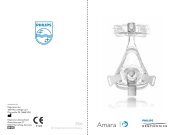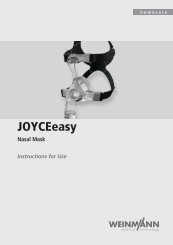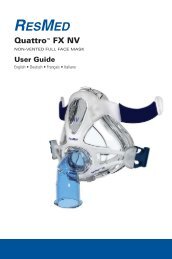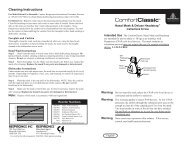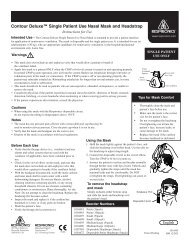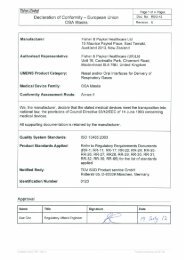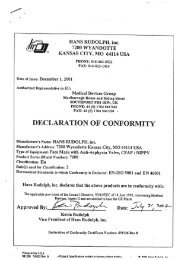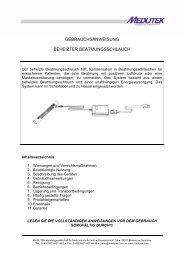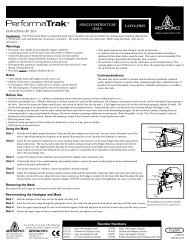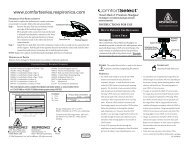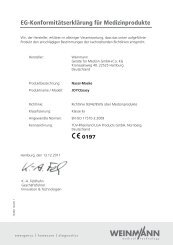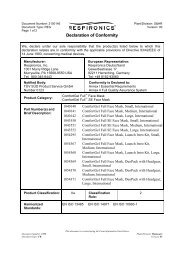Mirage™ SoftGel
Mirage™ SoftGel
Mirage™ SoftGel
Create successful ePaper yourself
Turn your PDF publications into a flip-book with our unique Google optimized e-Paper software.
Mirage <strong>SoftGel</strong><br />
nasal mask<br />
User Guide<br />
English • Deutsch • Français • Italiano
Mirage TM <strong>SoftGel</strong><br />
Fitting / Anlegen / Mise en place / Applicazione<br />
1 2 3<br />
4 5 6<br />
Removal / Abnehmen der Maske / Retrait / Rimozione<br />
della maschera<br />
1 2<br />
i
Mirage <strong>SoftGel</strong><br />
A<br />
11<br />
10<br />
12<br />
2<br />
1<br />
B C<br />
9<br />
3<br />
ii<br />
8<br />
7<br />
6<br />
5<br />
4
Mask components / Maskenkomponenten / Composants<br />
du masque / Componenti della maschera<br />
Item /<br />
Artikel /<br />
Article /<br />
Articolo /<br />
Artikel<br />
Description / Beschreibung /<br />
Description / Descrizione / Beschrijving<br />
1 Mask frame / Maskenrahmen / Entourage<br />
rigide / Telaio della maschera / Maskerframe<br />
2 Dial / Drehregler / Molette de réglage /<br />
Selettore di regolazione / Draaiknop<br />
3 Forehead support / Stirnstütze / Support<br />
frontal / Supporto frontale / Voorhoofdsteun<br />
4 Forehead support pad / Stirnpolster /<br />
Tampon frontal / Imbottitura del supporto<br />
frontale / Kussentje van voorhoofdsteun<br />
5 <strong>SoftGel</strong> Cushion & clip / Maskenkissen und<br />
Clip / Bulle et clip / Cuscinetto e fermaglio /<br />
Kussentje en klem<br />
6 Cushion clip / Maskenkissen-Clip / Clip de la<br />
bulle / Fermaglio del cuscinetto / Klem voor<br />
kussentje<br />
7 Headgear clip / Kopfband-Clip / Clip<br />
d’attache du harnais / Fermaglio del<br />
copricapo / Hoofdbandklem<br />
8 Headgear / Kopfband / Harnais / Copricapo /<br />
Hoofdband<br />
9 Ports cap / Anschlusskappe / Bouchon<br />
d’entrées / Coperchio delle prese / Poortkap<br />
10 Swivel / Drehadapter / Pièce pivotante /<br />
Giunto rotante / Draaibare kop<br />
iii<br />
Part number /<br />
Artikelnummer /<br />
Code produit /<br />
Numero parte /<br />
Onderdeelnummer<br />
60180 (St)<br />
60193 (S)<br />
61289<br />
16393<br />
60123 (1)<br />
60124 (10)<br />
61631 (S)<br />
61632 (M)<br />
61633 (L)<br />
61634 (LW)<br />
60176 (St)<br />
60197 (S)<br />
16569 (2)<br />
16734 (10)<br />
16118 (S)<br />
16117 (M)<br />
16119 (L)<br />
16570 (2)<br />
16571 (10)<br />
16565<br />
11 Elbow / Kniestück / Coude / Gomito / Bocht 16387<br />
12 Vent / Luftauslassöffnung / Orifice<br />
de ventilation / Foro per l’esalazione /<br />
Ventilatieopening<br />
-
A Complete system / Komplettes System /<br />
Masque complet / Maschera con tutti i<br />
componenti / Volledig systeem<br />
B Elbow assembly / Kniestück mit<br />
Drehadapter / Coude / Complesso del<br />
gomito / Complete bocht<br />
iv<br />
61605 (S)<br />
61606 (M)<br />
61607 (L)<br />
61608 (LW)<br />
16399<br />
Also available / Außerdem erhältlich / Également disponible / Altri prodotti<br />
C Acriva LT Cushion & clip / Maskenkissen<br />
und Clip / Bulle et clip / Cuscinetto e<br />
fermaglio / Kussentje en klem<br />
60198 (S)<br />
60177 (M)<br />
60178 (L)<br />
60179 (LW)<br />
S Small / Small / Petit / Small / Small<br />
M Medium / Medium / Médium / Medium / Medium<br />
L Large / Large / Grand / Large / Large<br />
LW Large Wide / Large Wide / Large Wide / Grande larga / Large Wide<br />
St Standard / Standard / Standard / Standard / Standaard
Disassembly / Auseinanderbau / Démontage / Smontaggio<br />
1 2 3<br />
4<br />
5 6<br />
7 8 9<br />
v
Reassembly / Zusammenbau / Remontage /<br />
Riassemblaggio<br />
1 2 3<br />
4<br />
5 6<br />
7 8 9<br />
10 11 12<br />
vi
English<br />
Mirage TM <strong>SoftGel</strong><br />
nasal mask<br />
Thank you for choosing the Mirage <strong>SoftGel</strong>.<br />
The Mirage <strong>SoftGel</strong> is the first of ResMed’s masks offering a choice of two<br />
high performance cushions (Mirage <strong>SoftGel</strong> and Mirage Activa LT) on the one<br />
durable frame. For further information, refer to the Activa LT User Information<br />
section in this User Guide.<br />
Intended use<br />
The Mirage <strong>SoftGel</strong> channels airflow noninvasively to a patient from a positive<br />
airway pressure (PAP) device such as a continuous positive airway pressure<br />
(CPAP) or bilevel system.<br />
The Mirage <strong>SoftGel</strong> is:<br />
• to be used by adult patients (> 30 kg) for whom positive airway pressure<br />
has been prescribed<br />
• intended for single-patient re-use in the home environment and<br />
multipatient re-use in the hospital/institutional environment.<br />
Using your mask<br />
When using your mask with ResMed CPAP or bilevel devices that have mask<br />
setting options, refer to the Technical specifications section in this user guide<br />
for mask selection options.<br />
For a full list of compatible devices for this mask, see the Mask/Device<br />
Compatibility List on www.resmed.com on the Products page under Service<br />
& Support. If you do not have internet access, please contact your ResMed<br />
representative.<br />
Note:<br />
• If you experience nasal dryness or irritation, use of a humidifier is<br />
recommended.<br />
WARNING<br />
• The vent holes must be kept clear.<br />
• The mask should not be used unless the CPAP or bilevel device is<br />
turned on and operating properly.<br />
•<br />
Follow all precautions when using supplemental oxygen.<br />
1<br />
English
•<br />
•<br />
•<br />
•<br />
•<br />
•<br />
•<br />
•<br />
Oxygen flow must be turned off when the CPAP or bilevel device<br />
is not operating, so that unused oxygen does not accumulate<br />
within the CPAP or bilevel device enclosure and create a risk of<br />
fire.<br />
At a fixed rate of supplemental oxygen flow, the inhaled oxygen<br />
concentration varies, depending on the pressure settings, patient<br />
breathing pattern, mask, point of application and leak rate.<br />
The technical specifications of the mask are provided for your<br />
clinician to check that they are compatible with the CPAP or bilevel<br />
device. If used outside specification or if used with incompatible<br />
devices, the seal and comfort of the mask may not be effective,<br />
optimum therapy may not be achieved, and leak, or variation in<br />
the rate of leak, may affect the CPAP or bilevel device function.<br />
Discontinue using this mask if you have ANY adverse reaction to<br />
the use of the mask, and consult your physician or sleep therapist.<br />
Using a mask may cause tooth, gum or jaw soreness or aggravate<br />
an existing dental condition. If symptoms occur, consult your<br />
physician or dentist.<br />
As with all masks, some rebreathing may occur at low CPAP<br />
pressures.<br />
Refer to your CPAP or bilevel device manual for details on settings<br />
and operational information.<br />
Remove all packaging before using the mask.<br />
Cleaning your mask in the home<br />
Your mask and headgear should only be handwashed by gently rubbing in<br />
warm (approximately 30°C) water using mild soap. All components should<br />
be rinsed well with drinking quality water and allowed to air dry out of direct<br />
sunlight.<br />
Daily/After each use:<br />
• To optimise the mask seal, facial oils should be removed from the cushion<br />
after use.<br />
• Handwash the separated mask components (excluding headgear).<br />
• If the vent requires cleaning use a soft bristle brush.<br />
Weekly:<br />
•<br />
Handwash the headgear. It may be washed without being disassembled.<br />
2
•<br />
•<br />
•<br />
WARNING<br />
Do not use aromatic-based solutions or scented oils (eg,<br />
eucalyptus or essential oils), bleach, alcohol or products that<br />
smell strongly (eg, citrus) to clean any of the mask components.<br />
Residual vapours from these solutions can be inhaled if not rinsed<br />
thoroughly. They may also damage the mask, causing cracks.<br />
CAUTION<br />
If any visible deterioration of a system component is apparent<br />
(cracking, crazing, tears or cushion damage resulting in gel<br />
exposure, etc), the component should be discarded and replaced.<br />
Avoid connecting flexible PVC products (eg, PVC tubing) directly<br />
to any part of the mask. Flexible PVC contains elements that can<br />
be detrimental to the materials of the mask, and may cause the<br />
components to crack or break.<br />
Reprocessing the mask between patients<br />
This mask should be reprocessed when used between patients.<br />
Cleaning, disinfection and sterilization instructions are available from the<br />
ResMed website, www.resmed.com/masks/sterilization.<br />
If you do not have internet access, please contact your ResMed<br />
representative.<br />
3<br />
English
Troubleshooting<br />
Problem/possible cause Solution<br />
Mask is uncomfortable<br />
Headgear straps are too tight. Adjust straps evenly. The forehead<br />
support ‘anchors’ your mask and<br />
should sit firmly on your forehead.<br />
Fit is too tight. Wind out dial.<br />
Mask is too noisy<br />
Cushion clip is not inserted correctly. Remove cushion from frame and<br />
reinsert starting at the top.<br />
Check that the cushion clip is correctly<br />
inserted into the cushion and that<br />
the cushion is correctly clipped to the<br />
frame. If the problem persists, talk to<br />
your clinician.<br />
Ports cap or elbow incorrectly inserted. Remove the ports cap or elbow from<br />
the mask, then reassemble according<br />
to the instructions.<br />
Vent is blocked or partially blocked. If the vent requires cleaning, use a soft<br />
bristle brush.<br />
Mask leaks around the face<br />
Mask not positioned correctly. Gently pull the cushion away from the<br />
face to reinflate. Reposition your mask<br />
according to the instructions.<br />
Air leaking around the bridge of the<br />
nose.<br />
4<br />
Wind the dial in.<br />
Air leaking around the top of the lip. Wind the dial out and or tighten the<br />
bottom straps.<br />
The mask does not fit properly<br />
Cushion could be the wrong size. Talk to your clinician.<br />
Mask is incorrectly assembled. Disassemble the mask, then<br />
reassemble according to the<br />
instructions.<br />
Cushion may be dirty. Clean cushion according to the<br />
instructions.<br />
Cannot insert forehead support into mask frame<br />
The dial has been inserted into the<br />
frame before the forehead support.<br />
Push the end of the dial onto a hard<br />
surface until the dial comes out of the<br />
frame. Reassemble according to the<br />
instructions.
Technical specifications<br />
Pressure–flow<br />
curve<br />
Vent flow rate (L/min)<br />
60<br />
50<br />
40<br />
30<br />
20<br />
10<br />
Dead space<br />
information<br />
Therapy pressure 4 to 20 cm H 2 O<br />
The mask contains passive venting to protect against<br />
rebreathing. As a result of manufacturing variations, the vent<br />
flow rate may vary.<br />
0<br />
4 6 8 10 12 14 16 18 20<br />
Physical dead space is the empty volume of the mask to the end<br />
of the swivel. Using the large cushions it is 145 mL.<br />
Resistance Drop in pressure measured (nominal)<br />
at 50 L/min: 0.3 cm H 2 O<br />
at 100 L/min: 0.9 cm H 2 O<br />
Sound DECLARED DUAL NUMBERED NOISE EMISSION VALUES IN<br />
ACCORDANCE WITH ISO 4871<br />
Environmental<br />
conditions<br />
Gross dimensions<br />
Large:<br />
Mask setting<br />
options<br />
Mask pressure (cm H 2 0)<br />
The A weighted sound power level of the mask is 29 dBA, with<br />
uncertainty 3 dBA.<br />
The A-weighted sound pressure level of the mask at a distance<br />
of 1m is 22 dBA, with uncertainty 3 dBA.<br />
Operating temperature: +5°C to +40°C<br />
Operating humidity: 15% to 95% relative humidity<br />
non-condensing<br />
Storage and transport: -20°C to +60°C<br />
Storage and transport humidity: up to 95% relative humidity<br />
non-condensing<br />
Mask fully assembled – no headgear<br />
155 mm (H) x 91 mm (W) x 118 mm (D)<br />
Select ‘ACTIVA’ (if available), otherwise select ‘STANDARD’ as<br />
the mask option.<br />
Notes:<br />
• The mask system does not contain latex, PVC or DEHP materials.<br />
• The manufacturer reserves the right to change these specifications<br />
without notice.<br />
5<br />
Pressure<br />
(cm H 2 O)<br />
4 19<br />
8 28<br />
12 34<br />
16 40<br />
20 45<br />
Flow<br />
(L/min)<br />
English
Storage<br />
Ensure that the mask is thoroughly clean and dry before storing it for any<br />
length of time. Store the mask in a dry place out of direct sunlight.<br />
Disposal<br />
This mask does not contain any hazardous substances and may be disposed of<br />
with your normal household refuse.<br />
Symbols<br />
Caution, consult accompanying documents; LOT Lot number; REF Part<br />
number; Temperature limitation; Humidity limitation; Does not<br />
contain latex; Manufacturer; Indicates a Warning or Caution and alerts<br />
you to a possible injury or explains special measures for the safe and effective<br />
use of the device. Keep away from rain; This way up; Fragile, handle<br />
with care.<br />
Consumer warranty<br />
ResMed acknowledges all consumer rights granted under the EU Directive<br />
1999/44/EG and the respective national laws within the EU for products sold<br />
within the European Union.<br />
6
Deutsch<br />
Mirage TM <strong>SoftGel</strong><br />
nasEnmaskE<br />
Vielen Dank, dass Sie sich für die Mirage <strong>SoftGel</strong> entschieden haben.<br />
Die Mirage <strong>SoftGel</strong> ist die erste Maske von ResMed, die dem Patienten die<br />
Auswahl zwischen zwei leistungsstarken Maskenkissen für den Einsatz mit<br />
einem haltbaren Maskenrahmen bietet (Mirage <strong>SoftGel</strong> und Mirage Activa LT).<br />
Weitere Informationen hierzu finden Sie im Abschnitt „Activa LT<br />
Benutzerinformationen“ in dieser Gebrauchsanweisung.<br />
Verwendungszweck<br />
Die Mirage <strong>SoftGel</strong> führt dem Patienten auf nicht-invasive Weise einen<br />
Luftfluss von einem PAP-Gerät (positiver Atemwegsdruck) wie z. B. einem<br />
CPAP- oder Bilevel-Gerät zu.<br />
Die Mirage <strong>SoftGel</strong> ist:<br />
• für erwachsene Patienten (> 30 kg) vorgesehen, denen positiver<br />
Atemwegsdruck verschrieben wurde, sowie<br />
• für den wiederholten Gebrauch durch einen einzelnen Patienten zu Hause<br />
sowie durch mehrere Patienten im Krankenhaus geeignet<br />
Verwendung der Maske<br />
Wenn Sie Ihre Maske mit CPAP- oder Bilevel-Geräten von ResMed verwenden,<br />
die über Maskeneinstelloptionen verfügen, lesen Sie sich dazu bitte den<br />
Abschnitt „Technische Daten“ in dieser Gebrauchsanweisung durch.<br />
Eine vollständige Liste der mit dieser Maske kompatiblen Geräte finden Sie<br />
in der Kompatibilitätsliste Maske/Gerät unter www.resmed.com auf der Seite<br />
Produkte unter Service & Unterstützung. Wenn Sie keinen Internetanschluss<br />
haben, wenden Sie sich bitte an Ihren ResMed-Vertreter.<br />
Hinweise: Sollte es zu Trockenheit der Nase oder Nasenreizungen kommen,<br />
empfiehlt sich die Verwendung eines Atemluftbefeuchters.<br />
•<br />
•<br />
•<br />
WARNUNG<br />
Die Ausatemöffnungen dürfen nicht blockiert sein.<br />
Die Maske darf nur verwendet werden, wenn das CPAP- bzw.<br />
Bilevel-Gerät eingeschaltet ist und ordnungsgemäß funktioniert.<br />
Bei zusätzlicher Sauerstoffgabe müssen alle<br />
Sicherheitsmaßnahmen eingehalten werden.<br />
1<br />
Deutsch
•<br />
•<br />
•<br />
•<br />
•<br />
•<br />
•<br />
•<br />
Wenn das CPAP- bzw. Bilevel-Gerät nicht in Betrieb ist, muss<br />
die Sauerstoffzufuhr abgeschaltet werden, so dass sich nicht<br />
verwendeter Sauerstoff nicht im Gehäuse des Geräts ansammelt,<br />
wo er eine Feuergefahr darstellen könnte.<br />
Bei konstanter Sauerstoffzugabe ist die Konzentration des<br />
eingeatmeten Sauerstoffs je nach Druckeinstellung, Atemmuster<br />
des Patienten, Maskentyp, Zufuhrstelle und Luftaustrittsrate<br />
unterschiedlich.<br />
Ihr Arzt kann anhand der technischen Daten der Maske ihre<br />
Kompatibilität mit dem CPAP- bzw. Bilevel-Gerät überprüfen.<br />
Werden die technischen Daten der Maske nicht beachtet bzw. wird<br />
die Maske mit nicht kompatiblen Atemtherapiegeräten verwendet,<br />
können Sitz, Komfort und Therapie beeinträchtigt werden.<br />
Außerdem können sich Leckagen bzw. Leckagevariationen negativ<br />
auf die Funktion des CPAP- bzw. Bilevel-Gerätes auswirken.<br />
Unterbrechen Sie den Gebrauch und konsultieren Sie Ihren Arzt,<br />
sobald IRGENDWELCHE Nebenwirkungen im Zusammenhang mit<br />
dem Gebrauch der Maske auftreten.<br />
Masken können Zahn-, Gaumen- oder Kieferschmerzen<br />
verursachen bzw. ein bestehendes Zahnleiden verschlimmern.<br />
Wenden Sie sich in einem solchen Fall an Ihren Arzt oder Zahnarzt.<br />
Wie bei allen Masken besteht bei niedrigen CPAP-Druckwerten das<br />
Risiko der Rückatmung.<br />
Informationen zu Einstellungen und Betrieb finden Sie in der<br />
Gebrauchsanweisung Ihres CPAP- bzw. Bilevel-Gerätes.<br />
Entfernen Sie vor dem Gebrauch der Maske alles<br />
Verpackungsmaterial.<br />
Reinigen der Maske zu Hause<br />
Waschen Sie die Maskenteile und das Kopfband nur per Hand in einer warmen<br />
Seifenlauge (30 °C). Reiben Sie sie vorsichtig ab. Spülen Sie alle Teile gründlich<br />
mit Trinkwasser ab und lassen Sie sie vor direktem Sonnenlicht geschützt<br />
trocknen.<br />
Täglich/Nach jedem Gebrauch:<br />
• Um die optimale Funktion der Maske zu gewährleisten, sollte das<br />
Maskenkissen nach der Verwendung von überschüssigem Hautfett befreit<br />
werden.<br />
• Waschen Sie die einzelnen Maskenteile (außer das Kopfband) mit der<br />
Hand.<br />
2
• Verwenden Sie zur Reinigung der Ausatemöffnungen gegebenenfalls eine<br />
weiche Bürste.<br />
Wöchentlich:<br />
• Waschen Sie das Kopfband mit der Hand. Das Kopfband kann gewaschen<br />
werden, ohne dass es vorher auseinandergebaut werden muss.<br />
•<br />
•<br />
•<br />
WARNUNG<br />
Verwenden Sie zur Reinigung der Maskenteile keine aromatischen<br />
Lösungen oder Duftöle (z. B. Eukalyptus- oder ätherische Öle),<br />
Bleichmittel, Alkohol oder stark riechende Produkte (z. B. Zitrus).<br />
Es besteht die Gefahr, dass Sie Restdämpfe von diesen Lösungen<br />
einatmen, wenn Sie sie nicht gründlich ausspülen. Sie können<br />
außerdem die Maske beschädigen und Risse verursachen.<br />
VORSICHT<br />
Weist eines der Maskenteile sichtbare Verschleißerscheinungen<br />
auf (wie z B. Brüche, Risse oder Beschädigungen des<br />
Maskenkissens, die ein Eindringen von Gel ermöglichen), sollte es<br />
entfernt und durch ein neues ersetzt werden.<br />
Vermeiden Sie das direkte Anschließen flexibler PVC-Produkte<br />
(z. B. PVC-Schlauch) an die Teile dieser Maske. Flexible PVC-<br />
Produkte enthalten Elemente, die das Material der Maske<br />
beschädigen und zu Rissen oder Brüchen in den Komponenten<br />
führen können.<br />
Aufbereitung der Maske für einen neuen Patienten<br />
Vor Verwendung durch einen neuen Patienten muss die Maske aufbereitet<br />
werden.<br />
Anweisungen zur Reinigung, Desinfektion und Sterilisation finden Sie auf der<br />
ResMed-Website unter www.resmed.com/masks/sterilization.<br />
Wenn Sie keinen Internetanschluss haben, wenden Sie sich bitte an Ihren<br />
ResMed-Vertreter.<br />
3<br />
Deutsch
Fehlersuche<br />
Problem/Mögliche Ursache Lösung<br />
Maske ist unbequem.<br />
Die Kopfbänder sind zu<br />
stramm.<br />
Ziehen Sie die Bänder gleichmäßig an. Die<br />
Stirnstütze bildet einen zentralen Stützpunkt<br />
für Ihre Maske und muss sicher auf Ihrem Kopf<br />
sitzen.<br />
Die Maske ist zu eng. Drehen Sie den Regler auf.<br />
Die Maske ist zu laut.<br />
Der Maskenkissen-Clip wurde<br />
nicht richtig montiert.<br />
Anschlusskappe bzw.<br />
Kniestück sind nicht richtig<br />
eingeführt.<br />
Die Ausatemöffnung ist<br />
vollständig oder teilweise<br />
blockiert.<br />
Nehmen Sie das Maskenkissen vom<br />
Maskenrahmen ab und führen Sie es erneut<br />
ein. Beginnen Sie von oben.<br />
Stellen Sie sicher, dass der Maskenkissen-Clip<br />
richtig in das Maskenkissen eingeführt und<br />
dass das Maskenkissen richtig am Rahmen<br />
befestigt ist. Wird das Problem dadurch<br />
nicht behoben, wenden Sie sich an Ihren<br />
Maskenspezialisten.<br />
Nehmen Sie die Anschlusskappe bzw. das<br />
Kniestück von der Maske ab und bringen Sie<br />
beide Teile entsprechend den Anweisungen<br />
wieder an.<br />
Verwenden Sie zur Reinigung der<br />
Ausatemöffnung ggf. eine weiche Bürste.<br />
Es treten Maskenleckagen um das Gesicht herum auf.<br />
Maske sitzt nicht richtig. Ziehen Sie das Maskenkissen vorsichtig vom<br />
Gesicht weg, damit es sich erneut aufblasen<br />
kann. Legen Sie die Maske entsprechend den<br />
Anweisungen erneut an.<br />
Es treten Maskenleckagen um<br />
die Nasenwurzel herum auf.<br />
Es treten Maskenleckagen um<br />
die Oberlippe herum auf.<br />
Drehen Sie den Regler fest.<br />
Drehen Sie den Regler oder ziehen Sie die<br />
unteren Bänder fester an.<br />
4
Die Maske sitzt nicht richtig.<br />
Sie verwenden<br />
möglicherweise die falsche<br />
Maskenkissengröße.<br />
Die Maske ist nicht richtig<br />
zusammengebaut.<br />
Das Maskenkissen ist evtl.<br />
verschmutzt.<br />
Wenden Sie sich an Ihren Maskenspezialisten.<br />
Bauen Sie die Maske auseinander und<br />
entsprechend den Anweisungen wieder<br />
zusammen.<br />
Reinigen Sie das Maskenkissen gemäß den<br />
Anweisungen.<br />
Die Stirnstütze kann nicht in den Maskenrahmen eingesetzt werden.<br />
Der Drehregler wurde<br />
vor der Stirnstütze in den<br />
Maskenrahmen eingesetzt.<br />
Drücken Sie das Unterteil des Drehreglers auf<br />
eine harte Oberfläche, bis der Drehregler aus<br />
dem Maskenrahmen kommt. Bauen Sie die<br />
Maske entsprechend den Anweisungen wieder<br />
zusammen.<br />
5<br />
Deutsch
Technische Daten<br />
Druck-Fluss-<br />
Kurve<br />
Flussrate an den Ausatemöffnungen<br />
(l/min)<br />
60<br />
50<br />
40<br />
30<br />
20<br />
10<br />
Informationen<br />
zum Totraum<br />
Therapiedruck 4 bis 20 cm H 2 O<br />
Die Maske verfügt über einen passiven Luftauslass zum Schutz<br />
gegen Rückatmung. Aufgrund von Schwankungen beim Herstellungsprozess<br />
kann die Flussrate an den Ausatemöffnungen variieren.<br />
0<br />
4 6 8 10 12 14 16 18 20<br />
Der Totraum ist das Leervolumen der Maske bis zum Drehadapter.<br />
Bei der Kissengröße Large beträgt es 145 ml.<br />
Widerstand Gemessene Drucksenkung (Sollwert)<br />
bei 50 l/min: 0,3 cm H 2 O<br />
bei 100 l/min: 0,9 cm H 2 O<br />
Geräuschpegel ANGEGEBENER ZWEIZAHL-GERÄUSCHEMISSIONSWERT<br />
GEMÄSS ISO 4871<br />
Umgebungsbedingungen<br />
Abmessungen<br />
Large:<br />
Maskeneinstellungsoptionen<br />
Maskendruck (cm H 2 0)<br />
Der A-gewichtige Schalldruckpegel der Maske liegt bei 29 dBA (mit<br />
einem Unsicherheitsfaktor von 3 dBA).<br />
Der A-gewichtete Schalldruckpegel der Maske bei 1 m Entfernung<br />
liegt bei 22 dBA (mit einem Unsicherheitsfaktor von 3 dBA).<br />
Betriebstemperatur: +5 °C to +40 °C<br />
Betriebsluftfeuchtigkeit: 15 % bis 95% relative Luftfeuchtigkeit<br />
(ohne Kondensation)<br />
Aufbewahrungs- und Transporttemperaturen: -20 °C bis + 60°C<br />
Aufbewahrungs- und Transportluftfeuchtigkeit: bis zu 95% relative<br />
Feuchtigkeit ohne Kondensation<br />
Die Maske wird vollständig zusammengebaut und ohne Kopfband<br />
geliefert.<br />
L: 155 mm (H) x 91 mm (L) x 118 mm (B)<br />
Wählen Sie (falls vorhanden) „ACTIVA“ und ansonsten<br />
„STANDARD“ als Maskenoption aus.<br />
Hinweise:<br />
• Das Maskensystem ist latex-, PVC- und DEHP-frei.<br />
• Der Hersteller behält sich das Recht vor, diese technischen Daten ohne<br />
Vorankündigung zu ändern.<br />
6<br />
Druck<br />
(cm H 2 O)<br />
4 19<br />
8 28<br />
12 34<br />
16 40<br />
20 45<br />
Durchfluss<br />
(l/min)
Aufbewahrung<br />
Stellen Sie vor jeder Aufbewahrung sicher, dass die Maske sauber und trocken<br />
ist. Bewahren Sie die Maske an einem trockenen Ort und vor direktem<br />
Sonnenlicht geschützt auf.<br />
Entsorgung<br />
Die Maske enthält keine Gefahrenstoffe und kann mit dem normalen<br />
Haushaltsabfall entsorgt werden.<br />
Symbole<br />
Achtung: Lesen Sie bitte die beiliegenden Unterlagen; LOT Chargennummer;<br />
REF Artikelnummer; Temperaturbeschränkung; Luftfeuchtigkeitsgrenzen;<br />
Latexfrei; Hersteller; Dieses Symbol deutet auf eine Warnung oder<br />
einen Vorsichtshinweis hin und macht Sie auf mögliche Verletzungsgefahren<br />
aufmerksam bzw. erklärt besondere Maßnahmen für den sicheren und<br />
wirksamen Gebrauch der Maske; Vor Regen schützen; So herum;<br />
Zerbrechlich. Mit Vorsicht handhaben.<br />
Gewährleistung<br />
ResMed erkennt für alle innerhalb der EU verkauften Produkte alle<br />
Kundenrechte gemäß der EU-Richtlinie 1999/44/EWG sowie alle<br />
entsprechenden länderspezifischen Gesetze innerhalb der EU an.<br />
7<br />
Deutsch
Français<br />
Mirage TM <strong>SoftGel</strong><br />
masQUE nasal<br />
Merci d'avoir choisi le Mirage <strong>SoftGel</strong>.<br />
Le Mirage Softgel est le premier masque de la gamme ResMed offrant deux<br />
options de bulle de haute performance (Mirage <strong>SoftGel</strong> et Mirage Activa LT)<br />
sur le même entourage rigide durable.<br />
Pour plus d’informations, veuillez consulter la section Informations utilisateur<br />
sur l’Activa LT du manuel utilisateur.<br />
Usage prévu<br />
Le Mirage <strong>SoftGel</strong> achemine au patient de façon non-invasive le débit d'air<br />
produit par un appareil à pression positive tel qu'un appareil de PPC ou d'aide<br />
inspiratoire avec PEP.<br />
Le Mirage <strong>SoftGel</strong> est prévu :<br />
• pour une utilisation par des patients adultes (> 30 kg) à qui une pression<br />
positive a été prescrite ;<br />
• pour un usage multiple par un seul patient à domicile ou pour un usage<br />
multiple par plusieurs patients en milieu médical.<br />
Utilisation du masque<br />
En cas d'utilisation du masque avec un appareil de PPC ou d'aide inspiratoire<br />
avec PEP ResMed disposant d'une fonction de sélection du masque, veuillez<br />
consulter la partie Caractéristiques de ce manuel utilisateur pour davantage<br />
d'informations relatives à cette fonction.<br />
Pour une liste complète des appareils compatibles avec ce masque, veuillez<br />
consulter la liste de compatibilité entre les masques et les appareils sur le site<br />
www.resmed.com dans la page Produits sous la rubrique SAV et assistance.<br />
Si vous n'avez pas accès à Internet, veuillez contacter votre représentant<br />
ResMed.<br />
Remarque: En cas de sécheresse ou d'irritation nasale, il est recommandé<br />
d'utiliser un humidificateur.<br />
•<br />
•<br />
•<br />
AVERTISSEMENT<br />
Les orifices de ventilation ne doivent jamais être obstrués.<br />
Le masque ne doit être porté que si l’appareil de PPC ou d’aide<br />
inspiratoire avec PEP est sous tension et fonctionne correctement.<br />
Prenez toutes les précautions applicables lors de l'adjonction<br />
d'oxygène.<br />
1<br />
Français
•<br />
•<br />
•<br />
•<br />
•<br />
•<br />
•<br />
•<br />
L'arrivée d'oxygène doit être fermée lorsque l'appareil n'est pas<br />
en marche afin d'empêcher l'oxygène inutilisé de s'accumuler<br />
dans le boîtier de l'appareil de PPC ou d'aide inspiratoire avec PEP<br />
et de créer un risque d'incendie.<br />
Lorsque de l’oxygène supplémentaire est délivré à un débit<br />
fixe, la concentration de l’oxygène inhalé varie en fonction des<br />
réglages de pression, de la respiration du patient, du masque, du<br />
point d'arrivée de l'oxygène ainsi que du niveau de fuites.<br />
Les caractéristiques de votre masque sont fournies afin que votre<br />
prestataire de soins puisse vérifier que celui-ci est compatible<br />
avec votre appareil de PPC ou d'aide inspiratoire avec PEP.<br />
L'utilisation du masque en dehors de ses caractéristiques ou avec<br />
des appareils incompatibles peut compromettre son étanchéité et<br />
son confort ainsi que l'efficacité du traitement, et les fuites ou la<br />
variation du niveau de fuites peuvent affecter le fonctionnement<br />
de l'appareil de PPC ou d'aide inspiratoire avec PEP.<br />
Cessez d'utiliser ce masque en cas de réaction indésirable<br />
QUELCONQUE à l'un des composants du masque et consultez<br />
votre médecin traitant ou votre spécialiste du sommeil.<br />
L'utilisation d'un masque peut provoquer des douleurs dans les<br />
dents, les gencives ou la mâchoire ou aggraver un problème<br />
dentaire existant. Si des symptômes se manifestent, veuillez<br />
consulter votre médecin ou votre dentiste.<br />
Comme c'est le cas avec tous les masques, une réinhalation peut<br />
se produire à une pression PPC basse.<br />
Veuillez consulter le manuel d'utilisation de votre appareil de PPC<br />
ou d'aide inspiratoire avec PEP pour davantage d'informations sur<br />
les réglages et le fonctionnement.<br />
Retirez tout l'emballage avant utilisation du masque.<br />
Nettoyage du masque à domicile<br />
Nettoyez le masque et le harnais à la main en les frottant légèrement dans<br />
de l'eau tiède (30°C environ) à l'aide d'un savon doux. Rincez soigneusement<br />
tous les composants à l'eau potable et laissez-les sécher à l'abri de la lumière<br />
directe du soleil.<br />
2
Quotidien/Après chaque utilisation :<br />
• Pour optimiser l'étanchéité du masque, toute trace de sébum doit être<br />
retirée de la bulle après utilisation.<br />
• Nettoyez chaque composant du masque à la main (à l'exception du<br />
harnais).<br />
• Si les orifices sont sales, utilisez une brosse à poils doux pour les nettoyer.<br />
Hebdomadaire :<br />
• Nettoyez le harnais à la main. Il n'est pas nécessaire de le démonter pour<br />
le nettoyer.<br />
•<br />
•<br />
•<br />
AVERTISSEMENT<br />
Ne pas utiliser de solutions ou huiles parfumées (par ex. de<br />
l'essence d'eucalyptus ou des huiles essentielles), d’eau de<br />
Javel, d’alcool ou de produits fortement parfumés (par ex.<br />
au citron) pour le nettoyage des composants du masque. Les<br />
vapeurs résiduelles de ces produits peuvent être inhalées si<br />
les composants ne sont pas correctement rincés. Ces produits<br />
peuvent également endommager le masque et provoquer des<br />
fissures.<br />
ATTENTION<br />
En cas de détérioration visible d’un des composants du masque<br />
(par ex. fissures, fendillements, déchirures ou détérioration de la<br />
bulle provoquant une fuite de gel, etc.), le composant en question<br />
doit être jeté et remplacé.<br />
Éviter de raccorder des produits en PVC souple (par ex. un tube<br />
en PVC) directement aux composants de ce masque. Le PVC<br />
souple contient des éléments qui peuvent altérer les matériaux du<br />
masque et entraîner leur fissuration ou leur rupture.<br />
Désinfection du masque entre les patients<br />
Le masque doit être désinfecté ou stérilisé entre chaque patient.<br />
Les instructions de nettoyage, de désinfection et de stérilisation sont<br />
disponibles dans le Guide de désinfection et de stérilisation des masques<br />
que vous trouverez sur le site Web de ResMed, www.resmed.com/masks/<br />
sterilization.<br />
Si vous n'avez pas accès à Internet, veuillez contacter votre représentant<br />
ResMed.<br />
3<br />
Français
Dépannage<br />
Problème/cause possible Solution<br />
Le masque n'est pas confortable.<br />
Les sangles du harnais sont trop<br />
serrées.<br />
Ajustez les sangles à la même hauteur. Le<br />
support frontal participe au maintien du<br />
masque, et doit être positionné de façon<br />
appropriée.<br />
Le masque est trop serré. Dévissez la molette de réglage.<br />
Le masque fait trop de bruit.<br />
Le clip de la bulle n'est pas inséré<br />
correctement.<br />
Bouchon d'entrées ou coude mal<br />
inséré.<br />
Les orifices de ventilation sont<br />
partiellement ou totalement<br />
obstrués.<br />
Le masque fuit au niveau du visage.<br />
Retirez la bulle de l'entourage rigide et<br />
insérez-la de nouveau en commençant par<br />
le haut.<br />
Vérifiez que le clip de la bulle est inséré<br />
dans la bulle et que celle-ci est bien fixée à<br />
l'entourage rigide. Si le problème persiste,<br />
parlez-en à votre prestataire.<br />
Retirez le bouchon d'entrées et le coude<br />
du masque et remontez-le en suivant les<br />
instructions.<br />
Si les orifices de ventilation sont sales,<br />
utilisez une brosse à poils doux pour les<br />
nettoyer.<br />
Le masque est mal positionné. Retirez avec douceur la bulle du visage pour<br />
qu'elle se regonfle. Remettez le masque en<br />
place en suivant les instructions.<br />
Il y a une fuite d'air au niveau de<br />
l'arrête nasale.<br />
Il y a une fuite d'air au niveau de la<br />
lèvre supérieure.<br />
Le masque est mal ajusté.<br />
La bulle n'est peut-être pas de la<br />
bonne taille.<br />
Le masque n'est pas<br />
correctement monté.<br />
Vissez la molette de réglage.<br />
Dévissez la molette de réglage et/ou serrez<br />
les sangles inférieures.<br />
Contactez votre prestataire.<br />
Démontez le masque et remontez-le en<br />
suivant les instructions.<br />
La bulle est peut-être sale. Nettoyez la bulle en suivant les instructions.<br />
Impossible d'insérer le support frontal dans l'entourage rigide du masque.<br />
La molette de réglage a été<br />
insérée dans l'entourage rigide<br />
avant le support frontal.<br />
Appuyez à l'arrière de la molette de réglage<br />
avec une surface dure pour la faire sortir de<br />
l'entourage rigide. Remontez l'appui frontal<br />
en suivant les instructions.<br />
4
Caractéristiques<br />
Débit aux orifices de ventilation (l/min)<br />
Courbe Pression/Débit Le masque possède une ventilation passive afin d'éviter<br />
toute réinhalation. En raison des variations de fabrication,<br />
le débit aux orifices de ventilation peut varier.<br />
60<br />
50<br />
40<br />
30<br />
20<br />
10<br />
0<br />
4 6 8 10 12 14 16 18 20<br />
Informations concernant<br />
l'espace mort<br />
Pression de traitement 4 à 20 cm H 2 O<br />
L'espace mort physique correspond au volume vide entre<br />
le masque et l'extrémité de la pièce pivotante. Avec les<br />
coussins Large, il est de 145 ml.<br />
Résistance Chute de pression mesurée (nominale)<br />
à 50 l/min : 0,3 cm H 2 O<br />
à 100 l/min : 0,9 cm H 2 O<br />
Niveau acoustique VALEURS D'ÉMISSION SONORE A DEUX CHIFFRES<br />
DÉCLARÉES CONFORMÉMENT À LA NORME ISO 4871<br />
Le niveau de puissance acoustique pondéré A du masque<br />
est 29 dBA, avec une tolérance de 3 dBA.<br />
Le niveau de pression acoustique pondéré A du masque à<br />
une distance d'1 m est 22 dBA, avec une tolérance de 3 dBA.<br />
Conditions ambiantes Température de fonctionnement : de +5°C à +40°C<br />
Humidité de fonctionnement : de 15 % à 95 % d'humidité<br />
relative (sans condensation)<br />
Température de stockage et de transport : de -20°C à<br />
+60°C<br />
Humidité de stockage et de transport : 95 % au maximum<br />
d'humidité relative sans condensation<br />
Dimensions brutes<br />
Grand:<br />
Fonction de sélection<br />
du masque<br />
Pression au masque (cm H 2 O)<br />
Masque entièrement assemblé – sans harnais<br />
155 mm (H) x 91 mm (l) x 118 mm (D)<br />
Sélectionnez « ACTIVA » (si disponible), sinon sélectionnez<br />
« STANDARD » comme réglage de masque.<br />
Remarques :<br />
• Le masque ne contient pas de latex, de PVC ni de DEHP.<br />
• Le fabricant se réserve le droit de modifier ces caractéristiques sans<br />
notification préalable.<br />
5<br />
Pression<br />
(cm H 2 O)<br />
4 19<br />
8 28<br />
12 34<br />
16 40<br />
20 45<br />
Débit<br />
(l/min)<br />
Français
Rangement<br />
Veillez à ce que le masque soit bien propre et sec avant de le ranger. Rangez le<br />
masque dans un endroit sec à l'abri de la lumière directe du soleil.<br />
Élimination<br />
Ce masque ne contient aucune substance dangereuse et peut être jeté avec<br />
les ordures ménagères.<br />
Symboles<br />
Attention, veuillez consulter la documentation jointe ; LOT Numéro de lot ;<br />
REF Code produit ; Limites de température ; Limites d'humidité ;<br />
Ne contient pas de latex ; Fabricant ; Indique un avertissement ou<br />
une précaution et vous met en garde contre le risque de blessure ou explique<br />
des mesures particulières permettant d’assurer une utilisation efficace et sûre<br />
de l’appareil ; Tenir à l'abri de la pluie ; Haut ; Fragile, manipuler avec<br />
précaution.<br />
Garantie consommateur<br />
ResMed reconnaît tous les droits de consommateur octroyés en vertu de la<br />
Directive européenne 1999/44/CE et les différentes législations nationales de<br />
l'UE sur la vente des biens de consommation au sein de l'UE.<br />
6
Italiano<br />
Mirage TM <strong>SoftGel</strong><br />
masCHERa nasalE<br />
Grazie per aver scelto la maschera Mirage <strong>SoftGel</strong>.<br />
La Mirage <strong>SoftGel</strong> è la prima maschera ResMed a offrire una scelta tra due<br />
cuscinetti dalle alte prestazioni (Mirage <strong>SoftGel</strong> e Mirage Activa LT) su un unico<br />
durevole telaio. Per maggiori informazioni, vedere la sezione Informazioni per<br />
l’utente Activa LT di questa guida.<br />
Indicazioni per l’uso<br />
La maschera Mirage <strong>SoftGel</strong> eroga in modo non invasivo al paziente il flusso<br />
d’aria proveniente da un dispositivo a pressione positiva alle vie respiratorie<br />
(PAP), ad esempio un sistema CPAP (a pressione positiva continua alle vie<br />
respiratorie) o bilevel.<br />
La Mirage <strong>SoftGel</strong>:<br />
• va utilizzata da pazienti adulti (>30 kg) cui sia stata prescritta una terapia a<br />
base di pressione positiva alle vie respiratorie;<br />
• è di tipo monopaziente nell’uso a domicilio e multipaziente in contesto<br />
ospedaliero.<br />
Uso della maschera<br />
Se si fa uso di apparecchi CPAP o bilevel ResMed dotati di opzioni di<br />
impostazione della maschera, vedere la sezione Specifiche tecniche in questa<br />
Guida per l’utente per il parametro da impostare.<br />
Per un elenco completo dei dispositivi compatibili con questa maschera,<br />
vedere la Tabella compatibilità maschera/apparecchio sul sito<br />
www.resmed.com, sotto Products alla voce Service and Support. Di lì si<br />
dovrà fare clic sul link Mask/Device Compatibility per poter scaricare la tabella.<br />
Se non si dispone di un accesso a Internet, rivolgersi al proprio rappresentante<br />
ResMed.<br />
Note: In caso di secchezza o irritazione nasale, si consiglia l’uso di un<br />
umidificatore.<br />
AVVERTENZA<br />
• I fori per l’esalazione devono essere tenuti liberi da ostruzioni.<br />
• La maschera non va usata a meno che l’apparecchio CPAP o<br />
bilevel non sia acceso e funzioni correttamente.<br />
•<br />
Seguire ogni precauzione nell’uso dell’ossigeno supplementare.<br />
1<br />
Italiano
•<br />
•<br />
•<br />
•<br />
•<br />
•<br />
•<br />
•<br />
È necessario spegnere l’ossigeno quando l’apparecchio CPAP<br />
o bilevel non è in funzione. In caso contrario l’ossigeno non<br />
utilizzato potrebbe accumularsi dentro l’involucro dell’apparecchio<br />
CPAP o bilevel e comportare un rischio di incendio.<br />
A un flusso fisso di ossigeno supplementare, la concentrazione<br />
dell’ossigeno inspirato varia a seconda delle impostazioni di<br />
pressione, dell’andamento della respirazione del paziente, della<br />
maschera, del punto di applicazione e del coefficiente di perdite.<br />
Le specifiche tecniche della maschera sono fornite cosicché il<br />
medico possa verificarne la compatibilità con l’apparecchio<br />
CPAP o bilevel. Usare la maschera al di fuori dei suoi parametri<br />
di utilizzo o con dispositivi non compatibili comporta il rischio<br />
che la sua tenuta e il suo comfort risultino inefficaci, che non<br />
sia possibile conseguire un livello ottimale di terapia, e che le<br />
perdite d’aria, o variazioni delle stesse, possano incidere sul<br />
funzionamento dell’apparecchio CPAP o bilevel.<br />
Qualora si riscontri una QUALSIASI reazione avversa in seguito<br />
all’uso della maschera, interromperne l’uso e rivolgersi al proprio<br />
medico o terapista del sonno.<br />
L’uso di una maschera può causare dolore a denti, gengive o<br />
mascella, o aggravare problemi odontoiatrici preesistenti. Se si<br />
riscontrano sintomi, rivolgersi al proprio medico o dentista.<br />
Come per tutte le maschere, alle basse pressioni CPAP può<br />
verificarsi la respirazione dell’aria già espirata.<br />
Consultare il manuale dell’apparecchio CPAP o bilevel per<br />
informazioni dettagliate sulle sue impostazioni e il suo uso.<br />
Rimuovere completamente la confezione prima di usare la<br />
maschera.<br />
Pulizia della maschera a domicilio<br />
Maschera e copricapo vanno lavati esclusivamente a mano strofinandoli<br />
delicatamente in acqua tiepida (circa 30°C) usando un sapone delicato.<br />
Sciacquare con cura tutti i componenti in acqua potabile e lasciarli asciugare<br />
all’aria e al riparo dalla luce solare diretta.<br />
Operazioni quotidiane/dopo ciascun uso:<br />
• Per ottimizzare la tenuta della maschera, rimuovere i grassi del viso dal<br />
cuscinetto dopo l’uso.<br />
• Lavare a mano i componenti della maschera separati (escluso il copricapo).<br />
• Se il foro per l’esalazione necessita di pulizia, usare uno spazzolino a setole<br />
morbide.<br />
2
Operazioni settimanali:<br />
• Lavare a mano il copricapo. Esso può essere lavato senza essere<br />
smontato.<br />
•<br />
•<br />
•<br />
AVVERTENZA<br />
Per la pulizia di tutti i componenti della maschera è sconsigliato<br />
l’uso di soluzioni a base di aromi (ad es. eucalipto oppure oli<br />
essenziali), candeggina e alcool, o prodotti dall’aroma pungente<br />
(ad es. di agrumi). In mancanza di un risciacquo estremamente<br />
accurato i vapori residui di queste soluzioni rischierebbero<br />
di essere inalati. Le soluzioni possono inoltre danneggiare la<br />
maschera, causando incrinature.<br />
ATTENZIONE<br />
In caso di deterioramento visibile di un componente (ad esempio<br />
incrinatura, cavillatura, strappo, danni al cuscinetto dovuti a<br />
esposizione al gel, ecc.), esso va gettato e sostituito.<br />
Si sconsiglia di connettere direttamente a una qualsiasi parte della<br />
maschera prodotti in PVC flessibile (ad esempio tubi in PVC). Il<br />
PVC flessibile contiene elementi che possono risultare dannosi<br />
per i materiali di cui è composta la maschera, e può causare<br />
l’incrinatura o rottura dei componenti.<br />
Rigenerazione della maschera tra un paziente e l’altro<br />
La maschera va rigenerata prima di utilizzarla con un nuovo paziente.<br />
Le istruzioni per pulizia, disinfezione e sterilizzazione sono disponibili sul sito<br />
ResMed all’indirizzo www.resmed.com/masks/sterilization.<br />
Se non si dispone di un accesso a Internet, rivolgersi al proprio rappresentante<br />
ResMed.<br />
3<br />
Italiano
Risoluzione dei problemi<br />
Problema/Possibile causa Soluzione<br />
La maschera è scomoda<br />
Le cinghie del copricapo sono<br />
troppo strette.<br />
La maschera è troppo stretta. Allentare il selettore.<br />
La maschera è troppo rumorosa<br />
Il fermaglio del cuscinetto non è<br />
inserito correttamente.<br />
Il coperchio delle prese<br />
o il gomito non è inserito<br />
correttamente.<br />
Il foro per l’esalazione è ostruito<br />
parzialmente o del tutto.<br />
Regolare le cinghie in modo uniforme. Il<br />
supporto frontale ‘àncora’ la maschera e deve<br />
poggiare in modo ben saldo contro la fronte.<br />
Estrarre il cuscinetto dal telaio e reinserirlo a<br />
partire dalla cima.<br />
Verificare che il fermaglio del cuscinetto sia<br />
inserito correttamente nel cuscinetto e che<br />
quest’ultimo sia a sua volta ben agganciato<br />
al telaio. Se il problema persiste, rivolgersi al<br />
proprio medico.<br />
Rimuovere coperchio delle prese e gomito<br />
dalla maschera, e riassemblarlo secondo le<br />
istruzioni.<br />
Se il foro per l’esalazione necessita di pulizia,<br />
usare uno spazzolino a setole morbide.<br />
Vi sono fuoriuscite d’aria dalla maschera intorno al viso<br />
La maschera non è posizionata<br />
correttamente.<br />
Vi sono fuoriuscite d’aria intorno<br />
al ponte nasale.<br />
Vi sono fuoriuscite d’aria intorno<br />
alla sommità del labbro.<br />
La maschera ha una cattiva tenuta<br />
Il cuscinetto potrebbe essere<br />
della misura sbagliata.<br />
La maschera è stata assemblata<br />
in modo scorretto.<br />
Il cuscinetto potrebbe essere<br />
sporco.<br />
Tirar via delicatamente il cuscinetto dal viso<br />
per rigonfiarlo. Riposizionare la maschera<br />
seguendo le apposite istruzioni.<br />
Stringere il selettore.<br />
Allentare il selettore o stringere le cinghie<br />
inferiori.<br />
Rivolgersi al proprio medico.<br />
Smontare la maschera e riassemblarla<br />
secondo le istruzioni.<br />
Pulire il cuscinetto secondo le istruzioni.<br />
Impossibile inserire il supporto frontale nel telaio della maschera<br />
Il selettore è stato inserito<br />
nel telaio prima del supporto<br />
frontale.<br />
Premere la parte finale del selettore su una<br />
superficie dura fino a che il selettore fuoriesce<br />
dal telaio. Riassemblare secondo le istruzioni.<br />
4
Specifiche tecniche<br />
Curva di<br />
pressione–<br />
flusso<br />
Flusso d’esalazione (L/min)<br />
60<br />
50<br />
40<br />
30<br />
20<br />
10<br />
Informazioni<br />
sullo spazio<br />
morto<br />
Pressione<br />
terapeutica<br />
La maschera è dotata di un sistema di aerazione passivo al fine<br />
di scongiurare il rischio di respirazione dell’aria precedentemente<br />
esalata. Il flusso d’esalazione potrebbe variare in seguito a variazioni<br />
di fabbricazione.<br />
0<br />
4 6 8 10 12 14 16 18 20<br />
Lo spazio morto è il volume vuoto effettivo della maschera fino<br />
alla fine del giunto rotante. Per i cuscinetti di misura Large questo<br />
volume è pari a 145 mL.<br />
tra 4 e 20 cm H 2 O<br />
Resistenza Caduta di pressione misurata (nominale)<br />
a 50 L/min: 0,3 cm H 2 O<br />
a 100 L/min: 0,9 cm H 2 O<br />
Emissioni<br />
acustiche<br />
Condizioni<br />
ambientali<br />
Dimensioni<br />
lorde<br />
Opzioni di<br />
impostazione<br />
della maschera<br />
Pressione alla maschera (cm H 2 O)<br />
NUMERO BINARIO EMISSIONI ACUSTICHE DICHIARATE<br />
SECONDO LA NORMA ISO 4871<br />
La potenza acustica della maschera secondo la ponderazione A è di<br />
29 dBA, con un margine d’errore di 3 dBA.<br />
Il livello di pressione acustica della maschera secondo la<br />
ponderazione A alla distanza di 1m è di 22 dBA, con un margine<br />
d’errore di 3 dBA.<br />
Temperatura d’esercizio: tra 5 e 40°C<br />
Umidità d’esercizio: 15-95% umidità relativa<br />
non condensante<br />
Conservazione e trasporto: tra -20 e +60°C<br />
Umidità di conservazione e trasporto: fino al 95% di umidità relativa<br />
non condensante<br />
Maschera completamente assemblata – senza copricapo<br />
L: 155 mm (A) x 91 mm (L) x 118 mm (P)<br />
Selezionare l’impostazione di maschera ‘ACTIVA’ (se disponibile) o in<br />
alternativa ‘STANDARD’.<br />
Note:<br />
• La maschera non contiene lattice, PVC o DEHP.<br />
• Il fabbricante si riserva il diritto di modificare queste specifiche senza<br />
preavviso.<br />
5<br />
Pressione<br />
(cm H 2 O)<br />
4 19<br />
8 28<br />
12 34<br />
16 40<br />
20 45<br />
Flusso<br />
(L/min)<br />
Italiano
Conservazione<br />
Assicurarsi che la maschera sia ben pulita e asciutta prima di metterla da parte<br />
per periodi prolungati. Conservare la maschera in luogo asciutto, al riparo dalla<br />
luce solare diretta.<br />
Smaltimento<br />
La maschera non contiene sostanze pericolose e può essere smaltita insieme<br />
ai normali rifiuti domestici.<br />
Simboli<br />
Attenzione, consultare la documentazione allegata; LOT Numero partita;<br />
REF Numero parte; Limitazione della temperatura; Limitazione<br />
dell’umidità; Non contiene lattice; Fabbricante; Indica un’avvertenza<br />
o precauzione e mette in guardia dal pericolo di lesioni o illustra le misure da<br />
prendere per garantire il buon funzionamento e la sicurezza dell’apparecchio;<br />
Tenere al riparo dalla pioggia; Alto; Fragile, maneggiare con cura.<br />
Garanzia per il consumatore<br />
ResMed riconosce tutti i diritti del consumatore previsti dalla direttiva<br />
UE 1999/44/CE e dalle leggi di ciascun Paese dell’UE per i prodotti<br />
commercializzati nei territori dell’Unione Europea.<br />
6
Mirage Activa LT<br />
nasal mask / nasEnmaskE / masQUE nasal /<br />
masCHERa nasalE<br />
User information<br />
English • Deutsch• Français •Italiano<br />
Cushion clip /<br />
Maskenkissen-Clip /<br />
Clip de la bulle /<br />
Fermaglio del<br />
cuscinetto<br />
60176 (St)<br />
60197 (S)<br />
English<br />
Please read this information in conjunction with your Mirage TM <strong>SoftGel</strong> User<br />
Guide when changing your Mirage <strong>SoftGel</strong> cushion to the Mirage Activa LT<br />
cushion.<br />
Intended use<br />
The Mirage Activa LT channels airflow noninvasively to a patient from a positive<br />
airway pressure device such as a continuous positive airway pressure (CPAP)<br />
or bilevel system.<br />
The Mirage Activa LT is:<br />
• to be used by adult patients (> 30 kg) for whom positive airway pressure<br />
has been prescribed<br />
• intended for single-patient re-use in the home environment and<br />
multipatient re-use in the hospital/institutional environment.<br />
1<br />
Cushion & clip /<br />
Maskenkissen und Clip /<br />
Bulle et clip /<br />
Cuscinetto e fermaglio<br />
60198 (S)<br />
60177 (M)<br />
60178 (L)<br />
60179 (LW)
Troubleshooting<br />
Problem/possible cause Solution<br />
Mask is uncomfortable<br />
Cushion incorrectly inflated. With the air turned off, adjust the straps so that you can<br />
insert two fingers between your cheek and the lower<br />
headgear strap.<br />
Technical specifications<br />
Dead space information The dead space of the mask varies according to<br />
cushion size. It is 185 mL for the Medium size.<br />
Resistance Drop in pressure measured (nominal)<br />
at 50 L/min: 0.1 cm H 2 O<br />
at 100 L/min: 0.7 cm H 2 O<br />
Sound DECLARED DUAL-NUMBER NOISE EMISSION<br />
VALUES in accordance with ISO 4871. The<br />
A-weighted sound power level of the mask is 30<br />
dBA, with uncertainty 3 dBA. The A-weighted sound<br />
pressure level of the mask at a distance of 1 m is<br />
22 dBA, with uncertainty 3 dBA.<br />
Gross dimensions<br />
S<br />
M, L, LW:<br />
Mask fully assembled – no headgear.<br />
141 mm (H) x 91 mm (W) x 107 mm (D)<br />
154 mm (H) x 95 mm (W) x 117 mm (D)<br />
Mask setting options Select ‘Activa’ (if available) or ‘Standard’ as the mask<br />
option when using the Mirage Activa LT with ResMed<br />
devices that have mask setting options.<br />
Deutsch<br />
Lesen Sie diese Informationen bitte als Ergänzung zu Ihrer Mirage TM <strong>SoftGel</strong><br />
Gebrauchsanweisung, wenn Sie vom Mirage <strong>SoftGel</strong> Maskenkissen zum<br />
Mirage Activa LT Maskenkissen wechseln.<br />
Verwendungszweck<br />
Die Mirage Activa LT führt dem Patienten auf nicht-invasive Weise einen<br />
Luftfluss von einem PAP-Atemtherapiegerät wie z. B. einem CPAP- oder<br />
Bilevel-Gerät zu.<br />
Die Mirage Activa LT ist:<br />
• für erwachsene Patienten (>30 kg) vorgesehen, denen positiver<br />
Atemwegsdruck verschrieben wurde<br />
• für den wiederholten Gebrauch durch einen einzelnen Patienten zu Hause<br />
sowie durch mehrere Patienten in der Klinik oder Schlafklinik geeignet.<br />
2
Fehlersuche<br />
Problem/Mögliche<br />
Ursache<br />
Maske ist unbequem<br />
Maskenkissen ist nicht richtig<br />
aufgeblasen.<br />
Technische Daten<br />
Informationen zum<br />
Totraum<br />
Lösung<br />
Stellen Sie die Bänder bei abgeschaltetem Luftfluss so<br />
ein, dass Sie zwei Finger zwischen Ihre Wange und das<br />
untere Kopfband schieben können.<br />
Der Totraum der Maske ist je nach Maskenkissengröße<br />
unterschiedlich. Bei Maskenkissengröße Medium<br />
beträgt er 185 ml.<br />
Widerstand Gemessene Drucksenkung (Sollwert)<br />
bei 50 l/min: 0,1 cm H 2 O<br />
bei 100 l/min: 0,7 cm H 2 O<br />
Geräuschpegel ANGEGEBENER ZWEIZAHL-<br />
GERÄUSCHEMISSIONSWERT nach ISO 4871. Der<br />
A-gewichtete Schalldruckpegel der Maske liegt bei<br />
30 dBA (mit einem Unsicherheitsfaktor von 3 dBA).<br />
Der A-gewichtete Schalldruckpegel der Maske<br />
bei 1 m Entfernung liegt bei 22 dBA (mit einem<br />
Unsicherheitsfaktor von 3 dBA).<br />
Abmessungen<br />
S<br />
M, L, LW:<br />
Die Maske wird vollständig zusammengebaut und ohne<br />
Kopfband geliefert.<br />
141 mm (H) x 91 mm (B) x 107 mm (T)<br />
154 mm (H) x 95 mm x (B) x 117 mm (T)<br />
Maskeneinstelloptionen Wählen Sie (falls vorhanden) „Activa“ und ansonsten<br />
„Standard“ als Maskenoption aus, wenn Sie die Mirage<br />
Activa LT zusammen mit ResMed-Geräten benutzen,<br />
die über Maskeneinstelloptionen verfügen.<br />
Français<br />
Veuillez lire ces informations en conjonction avec le guide utilisateur<br />
Mirage TM <strong>SoftGel</strong> lors du remplacement de la bulle Mirage <strong>SoftGel</strong> par la bulle<br />
Mirage Activa LT.<br />
Usage prévu<br />
Le Mirage Activa LT achemine au patient de façon non-invasive le débit d'air<br />
produit par un appareil à pression positive tel un appareil de PPC ou de VNDP.<br />
Le Mirage Activa LT est prévu :<br />
3
•<br />
•<br />
pour une utilisation par des patients adultes (> 30 kg) à qui une pression<br />
positive a été prescrite ;<br />
pour un usage multiple par un seul patient à domicile ou pour un usage<br />
multiple par plusieurs patients en milieu médical.<br />
Stratégie de dépannage<br />
Problème/cause possible Solution<br />
Le masque n'est pas confortable<br />
La bulle n'est pas<br />
correctement gonflée.<br />
Caractéristiques<br />
Informations concernant<br />
l’espace mort<br />
Lorsque le débit d'air est fermé, ajustez les sangles de<br />
manière à pouvoir insérer deux doigts entre votre joue<br />
et la sangle inférieure du harnais.<br />
L'espace mort du masque varie en fonction de la taille<br />
de la bulle. Pour la taille Medium, il est de 185 ml.<br />
Résistance Chute de pression mesurée (nominale)<br />
à 50 l/min : 0,1 cm H 2 O<br />
à 100 l/min : 0,7 cm H 2 O<br />
Niveau acoustique VALEURS D’ÉMISSION SONORE À DEUX<br />
CHIFFRES DÉCLARÉES conformes à la norme ISO<br />
4871. Le niveau acoustique pondéré A du masque<br />
est de 30dBA avec une incertitude de 3 dBA.<br />
Le niveau de pression acoustique pondéré A du<br />
masque à une distance d’1 m est de 22 dBA, avec<br />
une incertitude de 3 dBA.<br />
Dimensions brutes<br />
S<br />
M, L, LW :<br />
Fonction de sélection du<br />
masque<br />
Masque entièrement assemblé – sans harnais.<br />
141 mm (H) x 91 mm (W) x 107 mm (D)<br />
154 mm (H) x 95 mm (W) x 117 mm (D)<br />
Sélectionnez « Activa » (si disponible), sinon<br />
sélectionnez « Standard » comme réglage lors de<br />
l'utilisation de Mirage Activa LT avec les appareils<br />
ResMed ayant des options de réglage du masque.<br />
Italiano<br />
Leggere questo libretto informativo insieme alla Guida per l'utente di<br />
Mirage TM <strong>SoftGel</strong> nel passaggio dal cuscinetto Mirage <strong>SoftGel</strong> al cuscinetto<br />
Mirage Activa LT.<br />
Indicazioni per l'uso<br />
La maschera Mirage Activa LT eroga in modo non invasivo al paziente il flusso<br />
d'aria proveniente da un dispositivo a pressione positiva alle vie respiratorie, ad<br />
esempio un sistema CPAP (a pressione positiva continua alle vie respiratorie)<br />
o bilevel.<br />
4
La Mirage Activa LT:<br />
• va utilizzata da pazienti adulti (>30 kg) cui sia stata prescritta una terapia a<br />
base di pressione positiva alle vie respiratorie;<br />
• è di tipo monopaziente nell'uso a domicilio e multipaziente in contesto<br />
ospedaliero.<br />
Risoluzione dei problemi<br />
Problema/Possibile causa Soluzione<br />
La maschera è scomoda<br />
Il cuscinetto è stato gonfiato<br />
in modo non corretto.<br />
Specifiche tecniche<br />
Informazioni sullo spazio<br />
morto<br />
Ad aria spenta, regolare le cinghie in modo da poter<br />
inserire due dita tra la guancia e la cinghia inferiore del<br />
copricapo.<br />
Lo spazio morto della maschera varia secondo la misura<br />
del cuscinetto. Per la misura Medium esso è pari a<br />
185 mL.<br />
Resistenza Caduta di pressione misurata (nominale)<br />
a 50 L/min: 0,1 cm H 2 O<br />
a 100 L/min: 0,7 cm H 2 O<br />
Potenza acustica NUMERO BINARIO EMISSIONI ACUSTICHE<br />
DICHIARATE come da norma ISO 4871. La potenza<br />
acustica della maschera secondo la ponderazione A è<br />
di 30 dBA, con un margine di errore di 3 dBA. Il livello<br />
di pressione acustica della maschera secondo la<br />
ponderazione A alla distanza di 1 m è di 22 dBA, con<br />
un margine di errore di 3 dBA.<br />
Dimensioni lorde<br />
S<br />
M, L, LW:<br />
Opzioni di impostazione<br />
della maschera<br />
Maschera completamente assemblata – senza copricapo.<br />
141 mm (H) x 91 mm (W) x 107 mm (D)<br />
154 mm (H) x 95 mm (W) x 117 mm (D)<br />
Selezionare l'opzione di maschera ‘Activa’ (se<br />
disponibile) o ‘Standard’ quando si utilizza la Mirage<br />
Activa LT con apparecchi ResMed dotati di opzioni<br />
d’impostazione della maschera.<br />
5
Fitting and assembly / Anpassung und Zusammenbau /<br />
Ajustement et montage / Applicazione e assemblaggio<br />
1 3<br />
2<br />
4<br />
7 8<br />
9<br />
10<br />
5<br />
11<br />
6<br />
6
Manufacturer:<br />
ResMed Ltd 1 Elizabeth Macarthur Drive Bella Vista NSW 2153 Australia<br />
Distributed by:<br />
ResMed Corp 9001 Spectrum Center Boulevard San Diego CA 92123 USA<br />
ResMed (UK) Ltd 96 Milton Park Abingdon Oxfordshire OX14 4RY UK<br />
See www.resmed.com for other ResMed locations worldwide.<br />
Mirage <strong>SoftGel</strong> Nasal Mask<br />
Protected by patents: AU 741003, AU 766623, AU 775051, AU 777033, AU 785376, DE<br />
20122844.0, EP 1187647, EP 1187649, EP 1187650, EP 1314445, EP 1582230, EP 1621225, EP<br />
1640034, HK 1057714, JP 3686609, NZ 513052, NZ 526165, NZ 526166, NZ 526167, NZ 526168,<br />
NZ 542849, NZ 543939, US 6119693, US 6374826, US 6439230, US 6463931, US 6532961, US<br />
6557556, US 6581594, US 6691708, US 6823865, US 6860269, US 6997188, US 7011090, US<br />
7159587, US 7216647, US 7234466, US 7316230. Other patents pending.<br />
Protected by design registrations: AU 156663, AU 156665, AU 321676, DE 40301991.5, FR<br />
031425, FR 031430, JP 1192859, JP 1197930, NZ 411222, US D486227, US D487510, US<br />
D493521, US D493522, US D545960, US D567935. Others pending.<br />
Mirage is a trademark of ResMed Ltd and is registered in U.S. Patent and Trademark Office.<br />
© 2009 ResMed Ltd.<br />
Mirage Activa LT<br />
Protected by patents: AU 2001267133, AU 2002301370, AU 710733, AU 741003, AU 766623,<br />
AU 775051, AU 777033, AU 785376, CA 2261790, CA 2470671, DE 20122844.0, EP 0956069,<br />
EP 1187647, EP 1187649, EP 1187650, EP 1314445, EP 1334742, EP 1479406, EP 1582230, EP<br />
1621225, EP 1640034 , HK 1057714, HK 1071083, JP 3686609, JP 3802872, JP 4031422, NZ<br />
513052, NZ 526165, NZ 526166, NZ 526167, NZ 526168, NZ 542849, NZ 543939, US 6112746,<br />
US 6119693, US 6357441, US 6374826, US 6412487, US 6439230, US 6463931, US 6532961,<br />
US 6557556, US 6581594, US 6581602, US 6634358, US 6691708, US 6772760, US 6796308,<br />
US 6823865, US 6823869, US 6860269, US 6871649, US 6986352, US 6997188, US 7021311,<br />
US 7107989, US 7159587, US 7178527, US 7216647, US 7234466, US 7243651, US 7318439, US<br />
7487777. Other patents pending.<br />
Protected by design registrations: AU 156663, AU 156665, AU 321676, DE 40301991.5, EU<br />
985601, FR 031425, FR 031430, JP 1192859, JP 1197930, JP 1367396, NZ 411222, US D486227,<br />
US D487510, US D493521, US D493522, US D545960, US D567935, US D597661. Others<br />
pending.<br />
Mirage and Activa are trademarks of ResMed Ltd and are registered in U.S. Patent and<br />
Trademark Office.<br />
© 2009 ResMed Ltd.
618126/1 09 11<br />
MIRAGE SOFTGEL<br />
USER<br />
eUrope 1<br />
1 2<br />
3 4<br />
5 6<br />
6 1 8 1 2 6<br />
Global leaders in sleep and respiratory medicine www.resmed.com



